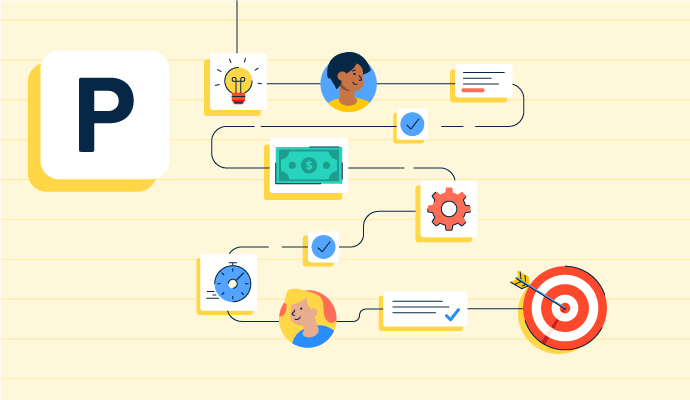What is project planning?
Project planning is the second stage of a four-step project management lifecycle. This stage, also referred to as work planning, follows initiation, where goals and objectives are outlined, and precedes execution, where the project deliverables are completed before the project is closed out.
Defining the elements of a project within the planning stage is critical for the best chance of success. During this stage, costs and resources are defined in more detail compared to the initiation stage, with important milestones mapped to establish the project’s estimated schedule.
The documentation produced during project planning is typically created and stored within project management software. This gives all relevant team members access to the information they need while the project is being worked on.
Types of project planning
Every team and each project they complete will approach project planning differently. But for most, project planning typically takes one of three forms:
- Vertical planning, also known as waterfall planning, is where a project manager maps each phase of the project sequentially, from beginning to end.
- Horizontal planning, or agile planning, is where various elements are planned simultaneously, regardless of where they fall in the schedule.
- Joint planning or integrated planning, is a mix of both horizontal and vertical planning, which incorporates elements of sequential and simultaneous planning throughout the project.
Basic elements of project planning
As the project plan needs to be a comprehensive map that guides the team, there are key pieces of information that must be included. These are:
- Project scope: This outlines what the team needs to deliver to consider the project successfully completed.
- Work breakdown: The project manager is responsible for breaking the larger project deliverables into smaller tasks, and then assigning these to individual team members.
- Schedule: Target milestones, along with any specific timelines that the team needs to be aware of, are all outlined in the schedule.
- Resource plan: Materials and equipment needed to complete the project, along with staff resources, must all be determined in this part of the project plan.
- Risk plan: All projects include some element of risk. Outlining this during project planning prepares the team with possible solutions for anticipated issues.
- Budget plan: Staying within budget is crucial. All costs related to the project, including equipment or staffing fees, should be laid out in the plan.
- Communication plan: Stakeholders will want to be updated on the project’s progress. A clear plan for communicating, including methods and frequency, should be included in project planning.
Benefits of project planning
While nothing can guarantee the success of a project, effective planning can significantly improve the odds of a positive outcome. Other benefits of project planning are:
- It saves money: Having a clear project plan is one of the best ways to stay within budget and avoid scope creep due to unexpected changes ahead of launch.
- It allocates resources more effectively: Knowing who is working on which parts of the project and how every milestone works towards a key performance indicator (KPI) or project goal means that resources are being used in the most appropriate way.
- It supports good communication: An effective project plan should outline how and when collaborators should be sharing their progress or ideas. This is especially important for remote teams collaborating on a project.
- It keeps the team aligned toward a clear goal: Everyone on the team will likely focus on the areas assigned to them, making it easy to forget how each part contributes to the whole project. Project planning gives a clear picture of how every part of the project fits together, creating a more unified and collaborative work atmosphere.
Best practices for project planning
Some projects will require more extensive planning than others. But no matter the scope or size, project planning should follow best practices such as:
- Documenting changes or plan updates: Even the most well-planned project can run into unexpected issues. If changes need to be made at any point, these should be documented in the project plan, with clear explanations as to why the change is necessary.
- Including team members in the planning stage: Everyone on the team brings their own unique viewpoint and skills. Including them throughout planning can give more objective insights into what will be needed to successfully complete the project.
- Getting approval from key stakeholders: Once a project plan has been drafted, any important company stakeholders or investors should have the opportunity to review it before final approval. This gives room for any miscommunications about expectations, scope, or budget to be addressed before the project work begins.
- Allocating extra time before launch: Work may take longer than expected. Building in additional time to the project schedule as a contingency prevents disappointing stakeholders and more breathing room for team members to try different approaches.
- Starting with the most complex items first: If possible, the most difficult parts of the project should be scheduled first. This gives the team more time to find solutions if problems occur, without the project having used a significant amount of the budget or resources before getting to this point.
Working together as a group is a crucial part of effective project planning. Using collaborative whiteboard software, your team can share ideas and move the project forward from wherever they are.

Holly Landis
Holly Landis is a freelance writer for G2. She also specializes in being a digital marketing consultant, focusing in on-page SEO, copy, and content writing. She works with SMEs and creative businesses that want to be more intentional with their digital strategies and grow organically on channels they own. As a Brit now living in the USA, you'll usually find her drinking copious amounts of tea in her cherished Anne Boleyn mug while watching endless reruns of Parks and Rec.

